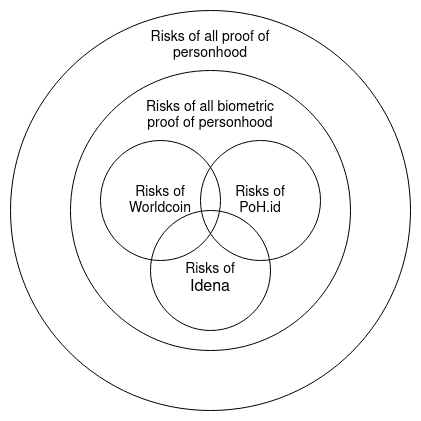One of the trickier, but potentially one of the most valuable, gadgets that people in the Ethereum community have been trying to build is a decentralized proof-of-personhood solution. Proof of personhood, aka the "unique-human problem", is a limited form of real-world identity that asserts that a given registered account is controlled by a real person (and a different real person from every other registered account), ideally without revealing which real person it is.
There have been a few efforts at tackling this problem: Proof of Humanity, BrightID, Idena and Circles come up as examples. Some of them come with their own applications (often a UBI token), and some have found use in Gitcoin Passport to verify which accounts are valid for quadratic voting. Zero-knowledge tech like Sismo adds privacy to many of these solutions. More recently, we have seen the rise of a much larger and more ambitious proof-of-personhood project: Worldcoin.
Worldcoin was co-founded by Sam Altman, who is best known for being the CEO of OpenAI. The philosophy behind the project is simple: AI is going to create a lot of abundance and wealth for humanity, but it also may kill very many people's jobs and make it almost impossible to tell who even is a human and not a bot, and so we need to plug that hole by (i) creating a really good proof-of-personhood system so that humans can prove that they actually are humans, and (ii) giving everyone a UBI. Worldcoin is unique in that it relies on highly sophisticated biometrics, scanning each user's iris using a piece of specialized hardware called "the Orb":

The goal is to produce a large number of these Orbs and widely distribute them around the world and put them in public places to make it easy for anyone to get an ID. To Worldcoin's credit, they have also committed to decentralize over time. At first, this means technical decentralization: being an L2 on Ethereum using the Optimism stack, and protecting users' privacy with ZK-SNARKs and other cryptographic techniques. Later on, it includes decentralizing governance of the system itself.
Worldcoin has been criticized for privacy and security concerns around the Orb, design issues in its "coin", and for ethical issues around some choices that the company has made. Some of the criticisms are highly specific, focusing on decisions made by the project that could easily have been made in another way - and indeed, that the Worldcoin project itself may be willing to change. Others, however, raise the more fundamental concern of whether or not biometrics - not just the eye-scanning biometrics of Worldcoin, but also the simpler face-video-uploads and verification games used in Proof of Humanity and Idena - are a good idea at all. And still others criticize proof of personhood in general. Risks include unavoidable privacy leaks, further erosion of people's ability to navigate the internet anonymously, coercion by authoritarian governments, and the potential impossibility of being secure at the same time as being decentralized.

This post will talk about these issues, and go through some arguments that can help you decide whether or not bowing down and scanning your eyes (or face, or voice, or...) before our new spherical overlords is a good idea, and whether or not the natural alternatives - either using social-graph-based proof of personhood or giving up on proof of personhood entirely - are any better.
What is proof of personhood and why is it important?
The simplest way to define a proof-of-personhood system is: it creates a list of public keys where the system guarantees that each key is controlled by a unique human. In other words, if you're a human, you can put one key on the list, but you can't put two keys on the list, and if you're a bot you can't put any keys on the list.
Proof of personhood is valuable because it solves a lot of anti-spam and anti-concentration-of-power problems that many people have, in a way that avoids dependence on centralized authorities and reveals the minimal information possible. If proof of personhood is not solved, decentralized governance (including "micro-governance" like votes on social media posts) becomes much easier to capture by very wealthy actors, including hostile governments. Many services would only be able to prevent denial-of-service attacks by setting a price for access, and sometimes a price high enough to keep out attackers is also too high for many lower-income legitimate users.
Many major applications in the world today deal with this issue by using government-backed identity systems such as credit cards and passports. This solves the problem, but it makes large and perhaps unacceptable sacrifices on privacy, and can be trivially attacked by governments themselves.
In many proof-of-personhood projects - not just Worldcoin, but also Proof of Humanity, Circles and others - the "flagship application" is a built-in "N-per-person token" (sometimes called a "UBI token"). Each user registered in the system receives some fixed quantity of tokens each day (or hour, or week). But there are plenty of other applications:
Airdrops for token distributions
Token or NFT sales that give more favorable terms to less-wealthy users
Voting in DAOs
A way to "seed" graph-based reputation systems
Quadratic voting (and funding, and attention payments)
Protection against bots / sybil attacks in social media
An alternative to captchas for preventing DoS attacks
In many of these cases, the common thread is a desire to create mechanisms that are open and democratic, avoiding both centralized control by a project's operators and domination by its wealthiest users. The latter is especially important in decentralized governance. In many of these cases, existing solutions today rely on some combination of (i) highly opaque AI algorithms that leave lots of room to undetectably discriminate against users that the operators simply do not like, and (ii) centralized IDs, aka "KYC". An effective proof-of-personhood solution would be a much better alternative, achieving the security properties that those applications need without the pitfalls of the existing centralized approaches
How does Worldcoin work?
Each Worldcoin user installs an app on their phone, which generates a private and public key, much like an Ethereum wallet. They then go in-person to visit an "Orb". The user stares into the Orb's camera, and at the same time shows the Orb a QR code generated by their Worldcoin app, which contains their public key. The Orb scans the user's eyes, and uses complicated hardware scanning and machine-learned classifiers to verify that:
The user is a real human
The user's iris does not match the iris of any other user that has previously used the system
If both scans pass, the Orb signs a message approving a specialized hash of the user's iris scan. The hash gets uploaded to a database - currently a centralized server, intended to be replaced with a decentralized on-chain system once they are sure the hashing mechanism works. The system does not store full iris scans; it only stores hashes, and these hashes are used to check for uniqueness. From that point forward, the user has a "World ID".
A World ID holder is able to prove that they are a unique human by generating a ZK-SNARK proving that they hold the private key corresponding to a public key in the database, without revealing which key they hold. Hence, even if someone re-scans your iris, they will not be able to see any actions that you have taken.
Privacy: while social-graph-based approaches avoid collecting biometric data, they often end up leaking info about a person's social relationships, which may lead to even greater risks. Of course, zero-knowledge technology can mitigate this (eg. see this proposal by Barry Whitehat), but the interdependency inherent in a graph and the need to perform mathematical analyses on the graph makes it harder to achieve the same level of data-hiding that you can with biometrics.
Inequality: each person can only have one biometric ID, but a wealthy and socially well-connected person could use their connections to generate many IDs. Essentially, the same flexibility that might allow a social-graph-based system to give multiple pseudonyms to someone (eg. an activist) that really needs that feature would likely also imply that more powerful and well-connected people can gain more pseudonyms than less powerful and well-connected people.
Risk of collapse into centralization: most people are too lazy to spend time reporting into an internet app who is a real person and who is not. As a result, there is a risk that the system will come over time to favor "easy" ways to get inducted that depend on centralized authorities, and the "social graph" that the system users will de-facto become the social graph of which countries recognize which people as citizens - giving us centralized KYC with needless extra steps.